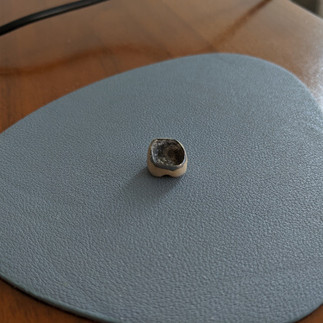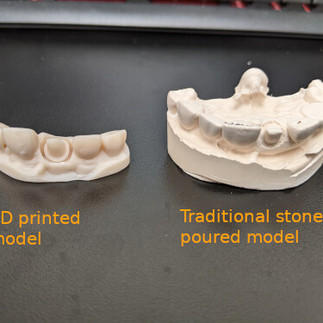This is a guide about porcelain fused to metal crowns (PFM crowns) which is a type of tooth cap used to restore and protect damaged teeth.

Table of Contents:
Overview
As its name implies, a porcelain fused to metal crown is a metal tooth cap which has porcelain fused over the exterior of it for aesthetics. They've been the workhorse of dentistry since they were introduced in the late 1950s. Their popularity has been declining since all ceramic crowns came unto the scene.
You can think of pfm crowns as a metal cap that has porcelain veneered over it for improved aesthetics.
The underlying base structure is made of metal for strength and structural integrity.
The overlying external layer is made of porcelain to mask the metal and provide an improved cosmetic appearance.
Notable features:
Functionality - You eat, chew, and speak with it the same way as other tooth caps.
Purpose - It is used to change the appearance of teeth, restore lost tooth structure, and protect weakened teeth.
Procedure - The process to get a PFM crown is the same as other types of materials. The only difference is that your dentist checks off one of the PFM options on the lab slip so the technician knows what material to make it.
When they're needed
There are many situations and dental conditions where you may benefit from having a tooth restored with a PFM crown.
After a root canal. The most common reason for getting this crown is after root canal treatment. When the nerve is removed, the blood supply gets removed along with it, thus making the tooth brittle and in need of protection.
Sizable chipped tooth. If you fracture off a large piece of your tooth, a filling would be inadequate to restore it. The next step would be a crown.
Large cavity. Tooth decay which has affected 50% or more of your tooth will need a crown. Fillings can't support such large cavities.
Essentially, porcelain fused to metal crowns are used to restore a tooth once it has been damaged. The metal substructure underneath provides protection and better structural integrity thus extending the life of your tooth.
Types of PFM crowns
Porcelain fused to metal crowns can be made from four different options:
Fused to non-precious metal
Fused to semi-precious metal
Fused to white high noble metal
Fused to yellow high noble metal

These options describe the type of metal that is fused to the porcelain.
The list provided above goes from least expensive to most expensive. The gist of it is that as it gets more expensive, there is simply a higher percentage of gold mixed into the metal.
What to expect for procedure
The process to get a PFM tooth cap will take a grand total of two separate visits. The first appointment will take roughly 45-60 minutes while the second will be 30-45 minutes. You will most likely be numb for both appointments if your tooth is still vital.
Overview of each appointment:
Visit 1: Tooth preparation, take an impression, and pick a tooth color.
Visit 2: Try in the permanent crown and glue it in permanently.
First appointment
Administer local anesthesia. Numbing gel first followed by Lidocaine injection.
Tooth preparation. Shave the tooth to the appropriate size to fit the new cap.
Pack cord. Place a cord around the gums to push them down and reveal the prepared margins for a more accurate impression (mold).
Take an impression. Take a mold of the prepared tooth and adjacent teeth. This gets sent to the lab for fabrication of the permanent restoration.
Fabricate a temporary crown. A temporary crown is made to protect the shaved down tooth while you wait for the permanent one. The temporary cap will be glued in with temporary cement so it can be removed more easily next visit.
Select tooth shade. The color of the porcelain can be selected to match your adjacent teeth so that it looks natural. This is done with a shade guide.

Second appointment
Administer local anesthesia.
Remove temporary crown. This is so you can try in the permanent one.
Clean cement residue. Old glue on the tooth needs to be removed for proper fit.
Try in the permanent crown. The try-in process is to make sure that it fits before it gets glued in. If it doesn't fit, it will need to be sent back for a do over.
Adjust the crown. If the new cap feels too tight, the contacts need to be adjusted. If the bite feels uneven, the occlusion will need an adjustment. Both of these can be done chairside by your dentist with a fine diamond football bur.
Polish. After all adjustments it is important to polish it so that it doesn't feel rough.
Permanently glue it in. Permanent cement will be used on this permanent crown so that it is less likely to fall off.
Appearance
Dental crowns that have porcelain fused to metal do look similar to other types of crowns (porcelain, ceramic, zirconia, emax, gold). The shape of the tooth will be identical to other types of tooth cap materials.
Photos of a premolar PFM crown:
Photos of a molar PFM crown:
Descriptive features:
All porcelain fused to metal crowns have an underlying metal substructure base.
The outer exterior consists of a layer of porcelain which can be made to be any tooth color. The whitest color for porcelain that is still natural would be B1 tooth shade.
Video
Below is a video showing you 360 degree views of a PFM crown. Being able to see it in three dimensions will give you a better idea of what it looks like.
Pros & Cons
Porcelain fused to metal crowns come with certain advantages and disadvantages. While they used to be the workhorse of dentistry in the 20th century, recently dentists have been switching to ceramic or porcelain only crowns.
Pros:
Durability - these crowns can last decades, they've been in service since the 1950s.
Great fit - the metal margins are more forgiving and give a tighter fit.
Long bridges - the metal substructure allows it to be used for long span dental bridges.
Cons:
Cosmetics - metal margins (black line) can show through the gums
Allergy - you could be allergic to the metal which contains nickel and cobalt.
Overall, the main disadvantage to having a PFM crown is the metal substructure underneath. Sometimes the metal margins can show through and patients abhor seeing a metal line by their gums. It is due to this singular reason that they've declined in popularity while ceramic caps have increased in popularity.
Below are photos demonstrating what we mean by having a dark metal line. They're all photos of the same crown but from different views. Some views you can see more metal.
Side effects
The primary adverse effect of a PFM crowns would be an allergic reaction to the metallic components. There have been reports of gold, nickel, and cobalt allergies.
Prevalence of metal allergies:
Subjects in one study had a 9.5% chance of being allergic to yellow gold.
A nickel allergy was found in 28.5% of one population that was examined.
Those with nickel allergies often had a concomitant allergy with cobalt.
If you're allergic to any of these material, you should choose a different type of crown material.
Compared to other crowns

There are pluses and minuses when porcelain metal crowns are compared to other types of crowns such as gold, ceramic, and all metal ones.

Below is a chart giving you an overview.
Attributes | PFM crown | Gold crown | Ceramic crown | Metal crown |
|---|---|---|---|---|
Durability | 10+ years | Decades | 8-10 years | Decades |
Cost | $$ | $$$ | $$ | $ |
Cosmetics | Acceptable | Unnatural | Natural looking | Worst aesthetics |
Function | Good | Good | Good | Good |
Biocompatible | Potential allergies | Very compatible | Very compatible | Potential allergies |
Dental glue | Cement only | Cement only | Cement or bond | Cement only |
Costs
The average cost of a PFM crown is $1300 and that is without any dental insurance. If you do have insurance, the cost would be $650 and that is based on the average coverage of 50%. Yes, most insurance plans will cover half of the cost of a crown.
Dental billing code: D2750
| Average cost | Cost range |
|---|---|---|
Without insurance | $1300 | $1000-$1800 |
With insurance (50% coverage) | $650 | $500-$900 |
The numbers given above are estimates based on a survey of dentists across the nation. Ultimately the biggest determining factors of cost would be the cost of living in your area and also how much your insurance covers.
Low cost of living will result in prices at the lower end while high cost of living will be at the higher price range.
The average insurance cover for crowns is 50% but we've seen some insurances cover more than that. If that is the case, this procedure could cost much less for you.
PFM vs ceramic crown cost
Below is a table comparing the cost of PFM crowns and all ceramic ones.
| PFM | Ceramic |
|---|---|---|
Average cost | $1300 | $1300 |
Cost range | $1000-$1800 | $1000-$1700 |
Average cost with insurance | $650 | $650 |
You may have been surprised but the price differences between the two materials isn't all that much. The reason is due to advances in dental technology which allow the ceramic crowns to be made by machine rather than by hand.
That technology is called CAD/CAM (computer assisted design and computer assisted manufacturing). Traditionally crowns had to be waxed up by hand and then baked in an oven, which is more labor intensive and costly.
Below are photos of the same patient's tooth model. One was poured in stone the traditional way while the other one was 3D printed.
The porcelain fused to metal caps can be made off of either one of the models.
























